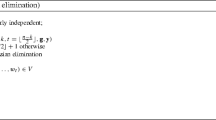Abstract
Galindo et al. introduced a class of codes which are obtained by evaluation of polynomials at the roots of a trace map (Galindo et al. in IEEE Trans Inform Theory 65: 2593–2602, 2019). Via subfield subcodes, this construction yields new linear codes with good parameters as well as good resulting quantum codes. Here, we extend this construction to allow evaluation at the roots of any polynomial which splits in the field of evaluation. Our proof relies on Galois-closedness of codes in consideration. Moreover, we introduce a lengthening process that preserves Galois-closed property of restricted evaluation codes. Subfield subcodes of such lengthened codes yield further good linear codes. In total, we obtain 17 linear codes over \(\mathbb {F}_4\) and \(\mathbb {F}_5\) which improve the best known linear code parameters in Grassl (Bounds on the minimum distance of linear codes and quantum codes, 2022, http://www.codetables.de). Moreover, we give a construction for two linear codes which have the best known parameters according to Grassl (Bounds on the minimum distance of linear codes and quantum codes, 2022, http://www.codetables.de), but for which no construction was known before.
Similar content being viewed by others
References
Bosma W., Cannon J., Playoust C.: The Magma algebra system. I. The user language. J. Symb. Comput. 24, 235–265 (1997).
Galindo C., Geil O., Hernando F., Ruano D.: On the distance of stabilizer quantum codes from \(J\)-affine variety codes. Quantum Inf. Process. 16, 111 (2017).
Galindo C., Hernando F., Ruano D.: Stabilizer quantum codes from \(J\)-affine variety codes and a new Steane-like enlargement. Quantum Inf. Process. 14, 3211–3231 (2015).
Galindo C., Hernando F., Ruano D.: Classical and quantum evaluation codes at the trace roots. IEEE Trans. Inform. Theory 65, 2593–2602 (2019).
Grassl, M.: Bounds on the minimum distance of linear codes and quantum codes. http://www.codetables.de. Accessed 30 June 2022
Huffman W.C., Pless V.: Fundamentals of error-correcting codes. Cambridge University Press, Cambridge (2003).
Stichtenoth H.: On the dimension of subfield subcodes. IEEE Trans. Inform. Theory 36, 90–93 (1990).
Acknowledgements
The authors are supported by a bilateral cooperation program between Korea and Turkey: TÜBİTAK project 120N932.
Author information
Authors and Affiliations
Corresponding author
Additional information
Publisher's Note
Springer Nature remains neutral with regard to jurisdictional claims in published maps and institutional affiliations.
This is one of several papers published in Designs, Codes and Cryptography comprising the “Special Issue: Coding and Cryptography 2022”.
Rights and permissions
Springer Nature or its licensor (e.g. a society or other partner) holds exclusive rights to this article under a publishing agreement with the author(s) or other rightsholder(s); author self-archiving of the accepted manuscript version of this article is solely governed by the terms of such publishing agreement and applicable law.
About this article
Cite this article
Güneri, C., Özbudak, F. & Sayıcı, S. On subfield subcodes obtained from restricted evaluation codes. Des. Codes Cryptogr. 92, 667–680 (2024). https://doi.org/10.1007/s10623-023-01261-1
Received:
Revised:
Accepted:
Published:
Issue Date:
DOI: https://doi.org/10.1007/s10623-023-01261-1




